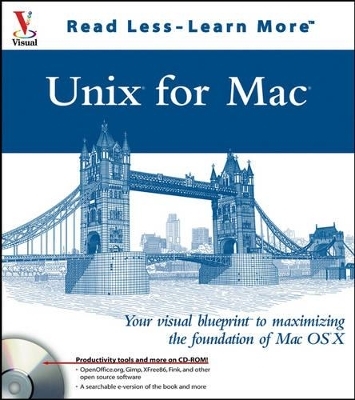
Unix for Mac
Hungry Minds Inc,U.S.
978-0-7645-3730-1 (ISBN)
- Titel ist leider vergriffen;
keine Neuauflage - Artikel merken
Mac OS X combines the Unix power developers need with Mac's ease of use, offering a unique combination of technical elements with enhanced performance, compatibility, and usability. This title shows readers how to use the Terminal application and the command interface, and explores the many Unix applications using step-by-step screen shots Readers will learn how to manage, create, edit, and transfer files; configure the Unix environment; navigate permissions, directories and files; run Unix utilities; and configure and run the Apache Web server.
HOW TO USE THIS BOOK. 1) GET STARTED WITH UNIX. Introduction to Unix. Start the Terminal Application. Configure the Terminal Application. Enter Unix Shell Commands. Shell Command Concepts. Read the Unix Manual. Exit the Terminal Window. 2) WORK WITH FILES. List Files. Show Hidden Files. Show File Attributes. Copy A File. Designate Files by Pathname. Rename a File. Delete a File. Change File Permissions. Select Files Using Wildcards. Select Files Using Completion. Find Files By Name. 3) WORK WITH DIRECTORIES. Change the Current Directory. Create a Directory. Delete a Directory. Move Files into a Directory. Copy a Directory. Determine Directory Size. 4) WORK WITH TEXT. View Text Files. Create a Simple Text File. View Text Files as Pages. View Portions of a Text File. Extract Text from a File. Redirect Text to a File. Chain Text Commands Together. Compare Text Files. Count Characters, Lines, and Words in Text. Arrange Text in Columns. Sorting Text. Print Text on a Printer. 5) WORK WITH TEXT EDITORS. Open a File with Pico. Edit a File with Pico. Open a File with vi. Movement Within vi. Enter Text in vi. Delete Text in vi. Edit Text with vi. Save a File with vi. Open a File with emacs. Edit a File with emacs. 6) CUSTOMIZE YOUR SHELL. Set Your Prompt. Set Command Aliases. Set Shell Variables. Set Environment Variables. Set Your Path. Edit Your .tcshrc File. Recall Your Command History. Start a New Shell. Change Your Shell. Work with the Bourne--Again Shell. Work with the Z Shell. 7) WORK WITH PROCESSES. Suspend the Current Process. Restart a Process. Run a Process in the Background. Kill a Process. List Active Processes. Monitor the Top Processes. 8) AUTOMATE SHELL TASKS. Write a Simple Shell Script. Run a Simple Shell Script. Write Looping Shell Scripts. Write A Conditional Shell Script. Extract Information with awk. Extend Scripts with sed. Schedule Scripts to Run Automatically. 9) COMBINE UNIX AND AQUA. Open Aqua Applications from the Shell. Capture a Screenshot from Unix. Access the Aqua Clipboard. Copy Apple Resource Forks. Run Applescript from the Shell. Create Clickable Shell Scripts. Drag Pathnames to the Terminal Window. 10) WORK WITH INTERNET COMMANDS. Connect to the Internet. Look Up an Internet Address. Look Up Domain Information. Examine Your Network Connection. Check that Another Computer Is Reachable. Log on to Another Computer. Transfer Files. Access Another Computer Securely. Download Web Files. Enable Remote Access to Your Computer. 11) SYSTEM ADMINISTRATION COMMANDS. Introduction to System Administration. Shut Down and Restart the Computer. Create a New User. Enable the Root User Account. Execute Commands as Root. Back Up Your Files. Change File Ownership. Create Symbolic Links. Check Disk Usage. Manage the Print Queue. Inspect System Logs. Compress Large Files. Using NetInfo. 12) INSTALL UNIX APPLICATIONS. Install Developer Tools. Find Unix Applications on the Web. Using Open Source Software. Find Open Source Software. Install Application Packages. Install TAR Archives. Compile a Program with make. Compile Apache. Manage Software Installation with Fink. Manage Fink with FinkCommander. Install Libraries. 13) INSTALL AND USE INTERNET APPLICATIONS. Install the Lynx Browser. Browse the Web with Lynx. Install Wget. Download Web Sites with Wget. Install an IRC Client. Chatting on IRC. Configure Sendmail. Send E--mail from UNIX. Look at Your Mail File. Fetch E--mail from Other Servers. Install Pine. Read E--mail with Pine. Send E--mail with Pine. 14) SERVE WEB PAGES WITH APACHE. Introduction to Apache. Start Apache. Stop Apache. Configure Apache. Set Up Your Document Directory. Create a Simple Web Site. Introduction to HTML. Create a Structured Web Page. Add Simple Styles to Your Web Site. Install CGI Scripts. Install Apache Modules. Write PHP Applications. Analyze Web Traffic. 15) WORK WITH PERL. Write a Simple Perl Script. Run a Perl Script. Manipulate Text with Perl. Read the Command Line. Read Files with Perl. Write Files with Perl. Install Perl Modules. Write a CGI Script. 16) RUN THE X WINDOW SYSTEM. Introduction to the X Window System. Get X Software for Mac OS X. Install an X Server. Install XFree86 Upgrades. Start XFree86 in Rootless Mode. Run the Gnome Desktop. Explore GNOME Applications. Install OroborOSX. 17) INSTALL X WINDOW SYSTEM SOFTWARE. View Images with xv. Edit Images with GIMP. Word Processing with AbiWord. Create Spreadsheets in Gnumeric. View Office Documents with Open Office. Create Spreadsheets with Open Office. 18) DEVELOP UNIX APPLICATIONS. Develop C and C++ Applications. Develop Java Applications. Develop Python Applications. Develop Ruby Applications. Run a Database on Mac OS X. Write SQL Commands. Access Databases from PHP. APPENDIX. What's on the CD--ROM. Using the E--Version of the Book. INDEX.
| Erscheint lt. Verlag | 28.4.2003 |
|---|---|
| Zusatzinfo | Illustrations |
| Verlagsort | Foster City |
| Sprache | englisch |
| Maße | 206 x 228 mm |
| Gewicht | 737 g |
| Einbandart | Paperback |
| Themenwelt | Informatik ► Betriebssysteme / Server ► Macintosh / Mac OS X |
| Informatik ► Betriebssysteme / Server ► Unix / Linux | |
| ISBN-10 | 0-7645-3730-X / 076453730X |
| ISBN-13 | 978-0-7645-3730-1 / 9780764537301 |
| Zustand | Neuware |
| Haben Sie eine Frage zum Produkt? |